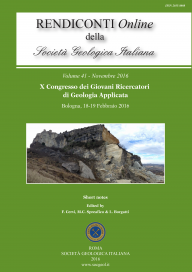
Geochemical characterization of the Bormio hydrothermal system (central Italian Alps)
Giorgio Volpi (a), Federico Riva (a), Fredy Alexander Peña Reyes (a), Stefano Basiricò (a) & Daniele Penna (b)
(a) University Milano-Bicocca DISAT (Department of Earth and Environmental Sciences), Piazza della Scienza, 4, 20126, Milano, Italy. E-mail: g.volpi4@campus.unimib.it
(b) Free University of Bolzano, Bolzano, Faculty of Science and Technology, Italy
Volume: 41/2016
Pages: 99-102
Abstract
The geothermal springs of Bormio (central Italian Alps) discharge from dolomite rock masses located close to a regional alpine thrust, called Zebrù Line. This particular geological setting allows the water to be heated in deep circulation systems and then to upsurge at a temperature of about 40°C at a vigorous flow rate. This paper aims to investigate deep-groundwater circulation of the Bormio hydrothermal system, based on the hydrochemical characterization of discharging groundwater. Water samples were collected during four campaigns in different seasons (June 2012, October 2012, May 2013 and September 2013) and analysed for major ions and stable isotopes. These tracers show that thermal groundwater flows through a deep system crossing both sedimentary and metamorphic lithotypes, and exploiting a fracture network associated to the thrusts between the Ortles Nappe and the overlaying Campo Nappe. The seasonal variations in temperature, electric conductivity and discharge were also compared. The results provide new insights into the hydrogeochemical characterization of large mountain areas where high variability of geochemical properties even at the local spatial scale represent an important challenge.
Keywords
Get Full Text